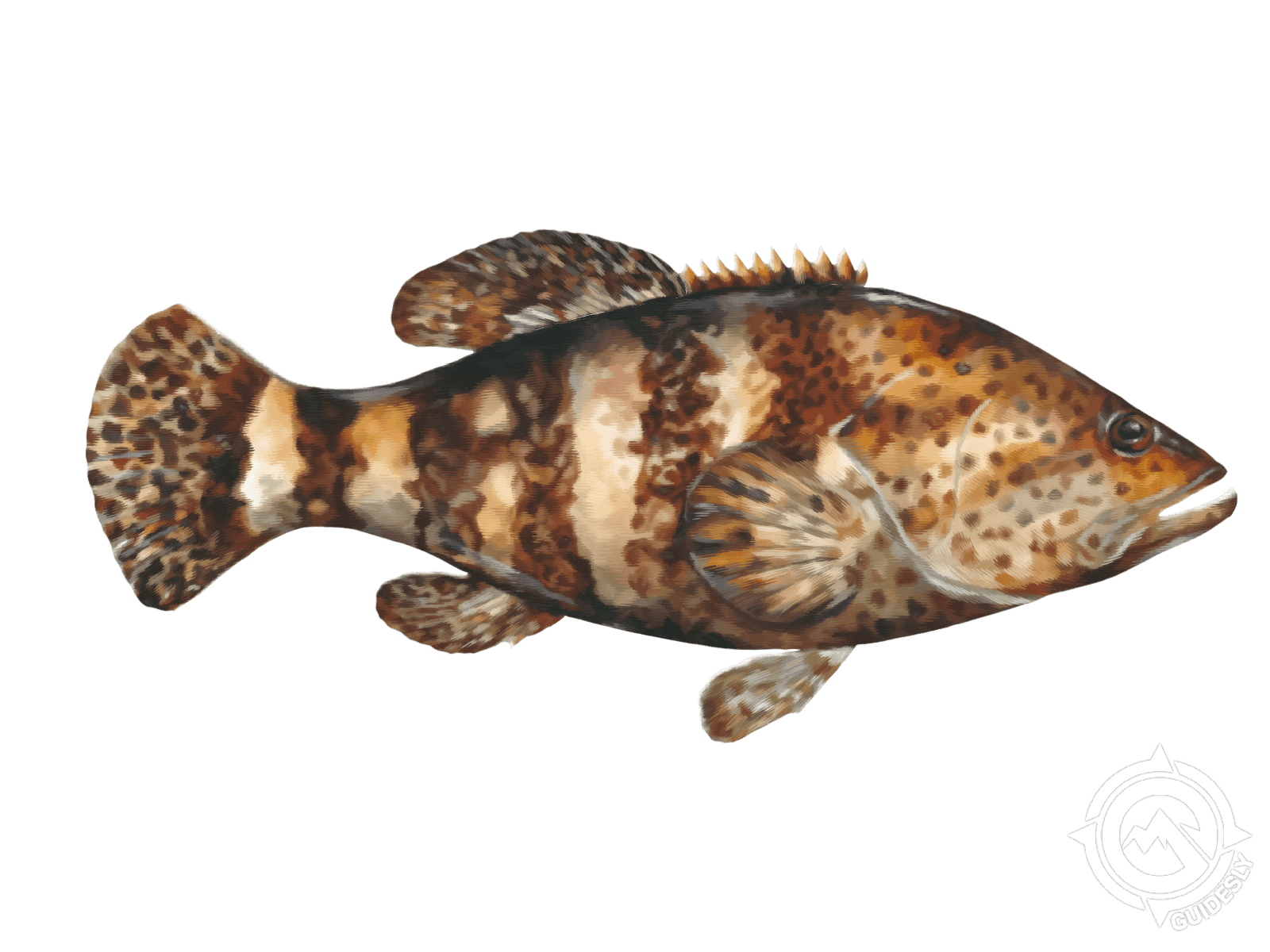Goliath Grouper

Species Details
Epinephelus Itajara
Serranidae
Perciformes
Onshore, Nearshore, Reef, Backcountry, Flats, Wreck
75 - 150 lbs.
50" - 98"
What is the Goliath Grouper?
The goliath grouper is the largest of its kind in the western Atlantic ocean. It grows up to 8 feet long and typically weighs around 800 pounds. All grouper are born female and some of them go through sex reversal and become males in maturity. Grouper have the ability to change color as a form of defense.
Goliath Grouper
Fish Description
As the name implies, this is a gigantic species of Grouper. As the biggest Grouper in the western Atlantic, they are stocky in shape, have tiny eyes and broadheads. Their pectoral and tail fins are connected along the back. They can live in brackish water and tolerate low oxygen levels.
They can grow to 8 feet in length and weigh up to 800 pounds.
Atlantic Goliath Grouper vs. Pacific Goliath Grouper
At one time, it was thought the Atlantic and Pacific Goliath Groupers were the same species, and centuries ago, they were the same species. They are now considered sister species. There are a few distinguishing marks between the two. The Pacific Goliath Grouper has primarily dark grey coloration, which is punctuated by small, white spots and blotches, and many times yellow accenting their fins. The Atlantic Goliath Grouper is mottled tan and grey. The Atlantic Grouper is also larger than the Pacific species.
Interesting Fish Facts
Adult Goliath Groupers gather together in spawning groups as soon as they prepared to mate. The groups vary in size, number, and location. Once they are together, the females lay eggs. Once the males fertilize the eggs, they rise to the surface of the water. The eggs then drift with the ocean currents for about 40 to 60 days, reaching the nursery areas as the baby groupers hatch out. These tiny groupers swim to the bottom of the ocean and hide in sea mangroves and grasses until they grow larger.
They may experience a sex reversal with age. All young groupers are female, but as they grow older, some become male. Only small percentages remain out of maturity long enough to become males, thus ensuring that most groupers are egg-laying females.
In addition to its potentially large size, an extra defense that some Groupers have is the ability to change their skin color. At times the color change is as simple as changing from dark to light to mix in with different light levels. Other Groupers have developed colorful patterns consisting of stripes, blotches, or spots that help them blend with the ocean floor and reef bottom.
Goliath Groupers are known to live 35 years, but now some scientists estimate the lifespan for these mammoth fish is 50 - 100 years.
Divers beware! These groupers are known to stalk divers.
Habitat & Distribution
Juveniles live and survive in canals, brackish estuaries, and mangrove swamps. When they mature, they move to shallow, tropical waters among coral or artificial reefs. Notably, they are one of the few groupers found in brackish water.
Goliath Grouper are loners. There are limited home ranges; these fish can be alone. They are primarily found in shallow, tropical waters in man-made and natural structures especially coral reefs. In the eastern Atlantic Ocean, they navigate yearly to a spawning area for breeding; the location and season vary according to the population.

The Goliath Grouper's population is concentrated in the Gulf of Mexico and the Florida Keys. Occasionally, they are found as far north as New England on the coast of Massachusetts and Maine.
They are also found in the Caribbean and parts of South America.
Bait and Lures
Goliath Groupers feed on sea turtles and crustaceans, mostly crabs. Other slow-moving fish such as burrfish, catfish, toadfish, and octopus will be found in their diet. These would be good fish to use as bait along with ladyfish and crevalle jack. Lures would be unsuccessful with these huge fish.
Fishing Techniques - How to Catch Goliath Grouper
The rod and reel you use need to be strong and extra-heavy since these fish are known to break gear. Goliath Grouper puts up an intense but usually short-lived fight. That first pull will be enough to pull you right off the boat if you are not careful, so be prepared. You will want a very heavy rod.
Considering the shallow water depth and size of this fish, we suggest a 50-80 wide reel. It should be sufficient to accommodate the 400 - 600 pound monofilament fishing line you will need. And as these fish live near rocks, reefs, and structures, you will need a line with some stretch. A 600-pound test monofilament fishing line is abrasion-resistant and will give you what you need. We also recommend a 20/O circle hook, big enough to get around the massive jaws of this fish.
The key to Grouper fishing is anchoring close enough to the reef so you can get the fish will come out to take the bait, but also distant enough to have a chance to pull them away from the reef before they try to get back and break you off. One important tip when fishing is to bounce the bait off the bottom to create some commotion. They have no predators, and they are not shy.
Is Goliath Grouper Good to Eat?
Goliath Grouper is known for its unique taste, which is unlike any other fish you’ve ever tried. It has a delicate white flesh that is mild, yet subtly sweet, making it a versatile ingredient that can be used in various recipes. The flavor profile of Goliath Grouper is exceptional, and it can easily soak up whatever seasoning or cooking techniques you choose to use, allowing you to create a dish that is personalized to your liking. Whether you prefer it grilled or baked, this fish will leave your taste buds longing for more. Its distinct flavor and texture make it a popular choice for seafood lovers who want to explore different tastes and experiences. So next time you’re looking for something different and exciting to try, consider the Goliath Grouper, and get ready to be pleasantly surprised!
Goliath Grouper Population
A dangerous combination of factors going against the Goliath is that they are sluggish fish that are slow to grow and reproduce. Secondly, considering their large size, they are found in relatively shallow waters of around 150 feet. These are a dangerous combination. They have experienced an estimated 80% population reduction because of overfishing. Because of this, all harvest of Goliath Groupers is forbidden by law.
Remember, these amazing fish are protected, and we all should be doing our part. Adhere to the rules of catch and release and leave these fish unharmed.
World Record
The world record for a hook-and-line caught Goliath Grouper is 680 pounds caught off Fernandina Beach, Florida, in 1961.








